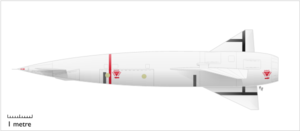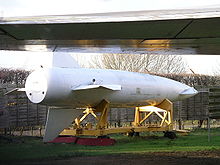Blue Steel Video - Overview
|
|
Blue Steel
Blue Steel

Type: Nuclear stand-off missile
Place of origin: UK
Service history:
In service: 1963-1970
Used by: UK RAF
Wars: (deterrent in the Cold War)
Production history:
Manufacturer: Avro
Number built: 53 operational live rounds
Variants: One/mod for low-level delivery
Specifications:
Weight: 17,000 lb (7,700 kg)
Length: 10.7 m (35 ft)
Diameter: 1.22 m (48 in) minimum
:
Warhead: Red Snow (W-28) thermonuclear (1.1 MT)
:
Engine: Liquid-fuel Armstrong Siddeley Stentor rocket
Wingspan: 4 m (13 ft)
Operational
range: 240 km (150 mi)
Flight ceiling: 21,500 m (70,500 ft)
Speed: Mach 2.3
Guidance
system: Inertial
Steering
system: Movable flight surfaces
Launch
platform: Aircraft
The Avro Blue Steel was a British air-launched, rocket-propelled nuclear stand-off missile, built to arm the V bomber force. It was the primary British nuclear deterrent weapon until the Royal Navy started operating Polaris missile armed nuclear submarines.
Development
![Airplane Picture - Avro Blue Steel nuclear missile (front) at the Midland Air Museum[2]](./images/1-images121310/220px-Avro_blue_steel_front_9m07.JPG)
Picture - Avro Blue Steel nuclear missile (front) at the Midland Air Museum[2]
Blue Steel was the result of a Ministry of Supply memorandum from 5 November 1954 that predicted that by 1960 Soviet air defences would make it prohibitively dangerous for V bombers to attack with nuclear gravity bombs. The answer was for a rocket-powered, supersonic missile capable of carrying a large nuclear (or projected thermonuclear) warhead with a range of at least 50 miles (80 km). This would keep the bombers out of range of Soviet ground-based defences installed around the target area, allowing the warhead to "dash" in at high speed.
There would have to be a balance between the size of the warhead (Orange Herald or Green Bamboo as developed by the AWRE) and the need for it to be carried by any of the three V-bomber types in use, and that it should be able to reach Mach 3. The Air Staff issued this requirement for a Stand-off bomb as OR.1132 in September 1954.

Picture - Avro Blue Steel missile (side view) at the Midland Air Museum behind the wing of an Avro Vulcan bomber.
The Ministry of Supply selected Avro out of the British manufacturers though it had no previous experience in working on guided weapons other than some private venture work; Handley Page had suggested a 500 nmi missile but the Elliots gyro based guidance system was inaccurate beyond 100 nmi. Avro began work proper in 1955, with the assigned Rainbow Code name of "Blue Steel" which it would keep in service. With Elliots working on the guidance system Armstrong Siddeley would develop the liquid fuel engine. Its design period was protracted, with various development problems exacerbated by the fact that designers lacked information on the actual size and weight of the proposed boosted-fission warhead Green Bamboo, or its likely thermonuclear successor derived from the Granite series. The large girth of Blue Steel was determined by the 45 inches (1.1 m) implosion sphere diameter of Green Bamboo.
Avro proposed that Blue Steel would evolve over time, subsequent versions increasing speed (to Mach 4.5) and range. The ultimate Blue Steel would be a 900 nmi range weapon that could be launched by the supersonic Avro 730 under development. They were told to limit themselves to the specification of OR.1132. The project was delayed by the need to develop the stainless steel fabrication techniques; this would have been gained in building the Avro 730 but that had been cancelled by then. Elliots guidance system was plagued by accuracy problems delaying test flights.
As it turned out, neither of these warheads were actually fitted, being superseded by Red Snow, an Anglicised variant of the U.S. W-28 thermonuclear warhead of 1.1 Mt yield. Red Snow was smaller and lighter than the earlier warhead proposals. The missile was fitted with a state-of-the-art inertial navigation unit. This system allowed the missile to strike within 100 metres of its designated target. In addition, the pilots of the Avro Vulcan or Handley Page Victor bombers could tie their systems into those of the missile and make use of the guidance system to help plot their own flight plan, since the unit in the missile was more advanced than that in the aircraft.
Blue Steel emerged as a pilotless, winged aircraft roughly the size of the experimental Saunders-Roe SR.53 interceptor, with clipped delta wings and small canard foreplanes. It was powered by a two-chamber Armstrong Siddeley Stentor Mark 101 rocket engine, burning a combination of hydrogen peroxide and kerosene. The fuel was a considerable operational problem, because fuelling the missile before launch took nearly half an hour, and was quite hazardous.
On launch the rocket engine's first chamber developing 24,000 lbf (110 kN) thrust would power the missile along a predetermined course to the target at around Mach 1.5. Once close to the target, the second chamber of the engine (6,000 lb) would accelerate the missile to Mach 3. Over the target the engine would cut out and the missile would free-fall before detonating its warhead as an Air burst.
To speed the trials at Woomera, the test rounds were flown there by Victors and Vulcans in Operation Blue Ranger. The trials began in 1960 about the time the original requirement expected the weapon to be in service.
Blue Steel finally entered service in February 1963, being carried by Vulcans and Victors, although its limitations were already apparent. The short range of the missile meant that the V bombers were still vulnerable to enemy SAMs. A replacement for Blue Steel, the Mark 2, was planned with increased range and a ramjet engine, but was cancelled in 1960 to minimise delays to the Mk.1. The UK sought to acquire the much longer-ranged United States Air Force AGM-48 Skybolt air-launched ballistic missile, and was greatly frustrated when that weapon was cancelled in late 1962.
With no effective long-range weapon the original Blue Steel served on after a crash programme of minor modifications to permit a low-level launch at 1,000 ft (300 m), even though its usefulness in a hot war was likely limited. A stop-gap weapon (WE.177B) was quickly produced to extend the life of the V-bomber force in the strategic role until the Polaris missile was deployed. This WE.177 laydown weapon supplemented the remaining modified Blue Steel missiles using a low-level penetration followed by a pop-up manoeuvre to release the weapon at 1,000 ft (300 m) Forty-eight live operational rounds were deployed on 48 Vulcan and Victor bombers plus a further five live rounds as operational spares. An additional four non-nuclear rounds were produced for various RAF requirements, and there were 16 other unspecified training rounds.
Blue Steel was officially retired on 31 December 1970, with the United Kingdom's strategic nuclear capacity passing to the submarine fleet.
Operator
United Kingdom
Royal Air Force - (V Bombers)
Specifications
Length: 10.7 m (35 ft)
Wingspan: 4 m (13 ft)
Diameter: 1.22 m (48 in) minimum
Launch Weight: 7,270 lb (3,300 kg)
Speed: Mach 2.3
Ceiling: 21,500 m (70,500 ft)
Maximum Range: 240 km (150 mi)
Guidance: Inertial
CEP: ~100 metres
Warhead: Red Snow thermonuclear (1.1 Mt)
Related content
Similar Weapons AGM-28 Hound Dog - Raduga KS-1 Komet
Rainbow Codes
Blue Steel Pictures and Blue Steel for Sale.
Living Warbirds: The best warbirds DVD series.
Source: WikiPedia